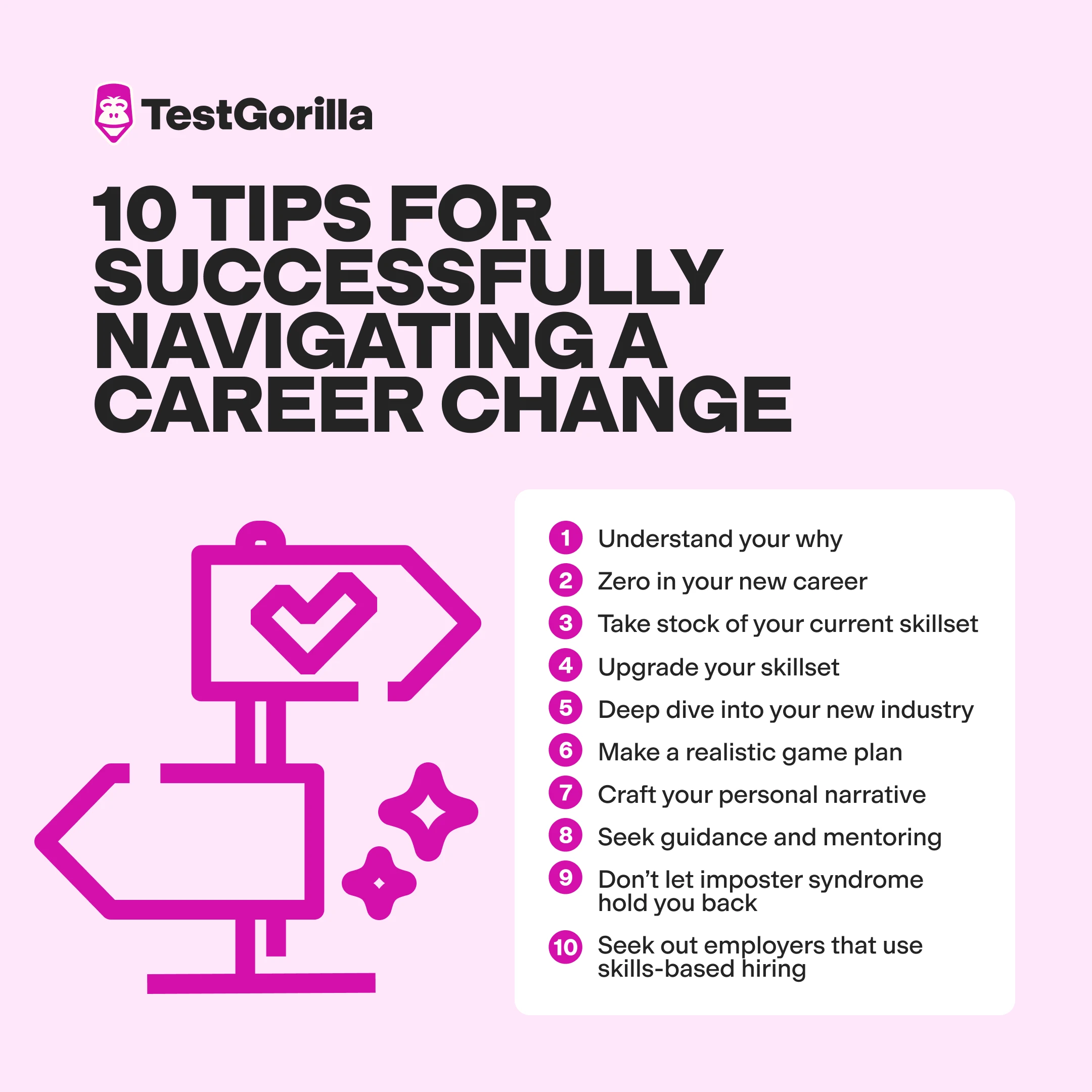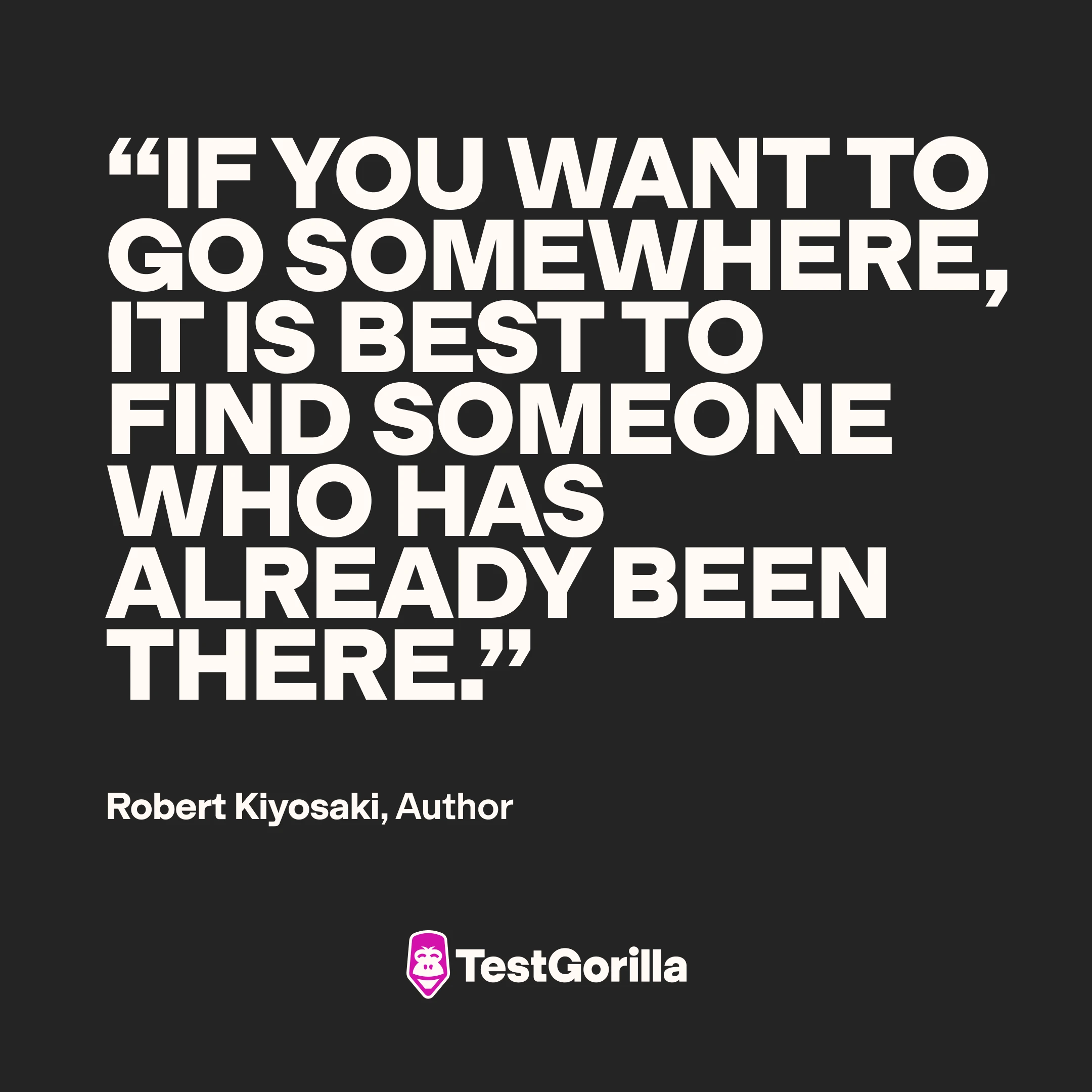10 tips for successfully navigating a career change
A career change can feel like stepping into the unknown. You might worry that your risk won’t pay off, you’ll have to start from scratch, or employers won’t take you seriously.
However, many people – from young professionals to seasoned C-suite executives – have successfully transitioned into new industries and roles at various stages of their careers.
In this article, we help you follow in their footsteps with our tips for navigating a career change and success stories to inspire you to take the leap and claim your dream career.
Key takeaways
Navigating a career transition can feel overwhelming, risky, and uncertain. But a successful career change can open exciting new opportunities and reignite your passion for your work.
Ways to help navigate a career shift include understanding why you want to change, assessing your skills, upskilling formally or informally, making a clear game plan, seeking guidance and support, and looking for employers who take a skills-based approach to hiring.
Table of contents
- 10 expert tips for managing a career transition
- 1. Understand your why
- 2. Zero in your new career
- 3. Take stock of your current skillset
- 4. Upgrade your skillset
- 5. Deep dive into your new industry
- 6. Make a realistic game plan
- 7. Craft your personal narrative
- 8. Seek guidance and mentoring
- 9. Don’t let imposter syndrome hold you back
- 10. Seek out employers that use skills-based hiring
- Get your dream job
- FAQs
10 expert tips for managing a career transition
1. Understand your why
When considering making a career change, you must understand why you want to do it. This helps you develop a clear plan and focus on new opportunities that align with your professional goals and values.
People change careers for various reasons, including when they’re:
Returning to work after having a child or accommodating other changes in life circumstances, such as moving to a new country
Suffering from burnout and fatigue in their current role
Feeling their current role doesn’t align with their values or passion
Wanting to earn more money
Knowing why you’re leaving your current role and industry helps you identify your motivations when looking for a new role. For instance, former journalist Audra Streetman said she moved into cybersecurity by identifying “two long-term goals: better work-life balance and a higher income.”
2. Zero in your new career
Once you know your motivations, picking a new career might be easy.
But what happens if you know you want to change careers but are unsure what to switch to?
In this case, it’s helpful to take some time to explore your options. Reflect on your interests outside of work and what you do well. Consider questions like:
What other industries/roles have you always been interested in?
What type of work do you prefer – for example, short-term contracts or permanent full-time positions?
How do you prefer to work – are you looking for a remote job, a hybrid role with flexible hours, or something else?
Your answers may help you zero in on the industry, role, or even company you’re most interested in.
Also, various online career tests may help you better understand your strengths, weaknesses, and work interests – which can inform your career choice. These include:
The US Department of Labor’s O-Net Interests Profiler
Self-Directed Search (paid)
Explore your interests outside your current work, too. Take a cooking class, volunteer for a cause you feel passionate about, or sign up for an online coding course to see what clicks.
3. Take stock of your current skillset
Once you know what you want to do next, you must figure out how to make the transition.
An excellent way to do this? Figure out the gap between the skills you have and the skills you need. This exercise helps you understand your transferable skills and the gaps you must address before making your career change.
Start by listing your skills based on your work experiences to date, including hard and soft skills. Then, identify the skills needed for your new career (online job descriptions for your dream job are good places to find these).
Changing careers can feel like starting from square one. But by comparing the two lists, you might be surprised to discover that many of your current skills are relevant and can transfer to your new role.
For example, this EMT worked in retail before moving to emergency medical services. He says, “There were some skills I had in retail that had transitioned smoothly into healthcare (ex, attention to detail, customer service, multi-tasking).”
Include these kinds of transferrable skills in your job applications and refer to them during interviews.
4. Upgrade your skillset
Assessing your current skillset also highlights the skills you need to develop before moving into a new industry and role.
Once you know these, you can figure out what training or experience you need and set professional development goals to gain the skills and knowledge you need. For instance, you could take a short online course or local college class. Other career transitions require more formal education, like a master’s degree.
But not all jobs require degrees or formal education, and there are other ways to gain the knowledge you need.
For example, volunteering can be a helpful way to gain exposure to new skills and experiences. Keisha “TK” Dutes was a healthcare professional when she started hosting a weekend radio show. Along with free online audio engineering classes, these were her first steps toward becoming a podcast host and producer.
5. Deep dive into your new industry
It pays to speak to as many people as possible about your new direction. This helps you build a picture of the skills, qualifications, and experience employers in the industry look for.
It’s also an excellent way to get information about practical considerations, like salary expectations and working conditions. Reaching out to others in the industry also helps you build a new professional network through which you might hear about new job opportunities.
You likely already have connections - or connections of connections - you can reach out to. You can also use job networking sites or forums, alumni networks, and professional associations to create new networks. Follow influential voices, send someone a message, invite them for a coffee, or tee-up a virtual chat. Most people are happy to talk to someone with a shared passion for their line of work.
6. Make a realistic game plan
Career transitions usually don’t happen overnight. They require detailed planning to ensure the transition is smooth and successful.
When putting together next steps, think about:
The time it’ll take to upskill or gain the necessary experience
Your contractual obligations to your current role, including notice periods, and how these will impact when and where you apply for new roles
Your financial situation and how to manage this during the transition
Your personal circumstances, including family obligations, and how they’ll impact the types of jobs you apply for, the possibility of relocation, and more
Everyone’s plan is unique. For instance, if you can’t afford to take any time off to change careers, you might start a side hustle in addition to your current job. This lets you test the waters and grow your side hustle until it can replace your full-time work. If your finances allow it, you might take a short career break to focus on upskilling – for example, by completing a full-time master’s degree.
7. Craft your personal narrative
Potential new employers may be curious about your decision to change careers. When preparing for your career change, be ready to explain your reasons. Craft an authentic narrative that showcases your unique story, sets out your reasons for moving in a new direction, and highlights the skills you bring to your new industry and role.
Some people believe that potential employers might view them as inexperienced or lacking direction when shifting careers. But it’s often the contrary. Thinking about your story helps you communicate your dedication, adaptability, and perseverance to hirers.
8. Seek guidance and mentoring
As the author Robert Kiyosaki says, “If you want to go somewhere, it is best to find someone who has already been there.”
You’re not the first person to change careers. For our 2024 State of Skills-Based Hiring report, we surveyed 1,100 employees worldwide. Fifty-two percent of employees aged 25-34 reported changing jobs or careers in the last 12 months, while 46% of employees aged 35-44 have done the same.
Many people understand how difficult it can be to break into a new industry and are happy to help if you ask.
Use your informal and formal professional networks to contact people for their advice and guidance on navigating the change. Finding a mentor in your new field is beneficial. They can be an excellent sounding board for your decision to change careers and any challenges that arise during the process.
9. Don’t let imposter syndrome hold you back
Career transitions often involve lots of uncertainty and doubt. Will I like my new job? Can I do the work? Will I find the job I’m looking for?
While these feelings are understandable, don’t let them sabotage your efforts. Focus on staying positive by framing the change as an exciting opportunity rather than an overwhelming challenge.
Business and career coach Murielle Marie suggests creating a “brag list” to build confidence. “On a piece of paper or a note on your computer or smartphone, make a list of all your accomplishments, big or small,” she says. “Whenever impostor syndrome creeps in and doubts start to swirl around in your head, take a look at your list and remind yourself of all the success you've achieved.”
Seek support if needed – from family and friends or from a professional. Career counseling can help you through these times.
10. Seek out employers that use skills-based hiring
When moving into a new industry, look for employers prioritizing skills over qualifications or experience. These companies are more likely to recognize and value transferable skills rather than dismissing you based on what may appear to be “unrelated experience” on your resume.
Our research also highlights the importance of skills-based hiring in finding your ideal role. According to our 2024 State of Skills-Based Hiring report, most employees (90%) say they’re more likely to secure their dream job with skills-based hiring. Eighty-one percent say skills-based hiring has given them access to new employment opportunities.
So, how do you find employers using a skills-based approach to hiring? Firstly, look closely at their job descriptions – skills will be front and center of their requirements. Also, check if the company uses skills tests during the hiring process. This suggests they’re interested in knowing candidates’ capabilities and fit beyond previous job titles.
Not convinced seeking out these employers will work? Well, take the case of Silvia as an example. After enduring some painful application processes – which involved tailored resumes and cover letters and lots of time-consuming data entry – she applied for a role as a product advisor and was asked to take an assessment. The process was simple, and it enabled her to show that she had the skills for the role.
As a result, she successfully switched from her previous gigs in politics and nannying to a new career as a product advisor and, eventually, a digital customer success advisor for TestGorilla.
Want to emulate her success? We’ve created a skills-first job board to make it even easier to find employers that use skills-based hiring. Rather than submitting a resume or written application, you simply ask to take a company’s assessment.
Get your dream job
Making a career transition can feel overwhelming and risky. However, there are various strategies you can use to navigate the shift successfully.
Take the time to understand your reasons for changing, audit your skills, make a solid plan, and find employers who use skills-based hiring.
Looking to connect with employers who prioritize talent, skills, and potential over previous job titles and degrees? Explore our job seeker hub, our job board, and our assessment guides today.
FAQs
How do you know if a career change is right?
A career transition may be right when you feel apathetic towards your work or lack purpose. Unmanageable stress levels and burnout are other signs of time for a change. You can find other more engaging and motivating work by exploring your professional strengths and interests.
Is 40 too old to change careers?
No, it’s never too late to make a career transition. Many people have done so in their 40s and later, motivated by a desire to continue learning or pursue a passion.
Related posts
You've scrolled this far
Why not try TestGorilla for free, and see what happens when you put skills first.
Latest posts
The best insights on HR and recruitment, delivered to your inbox.
Biweekly updates. No spam. Unsubscribe any time.

Skills tests to hire the best
Our screening tests identify the best candidates and make your hiring decisions faster, easier, and bias-free.
Free resources
A step-by-step blueprint that will help you maximize the benefits of skills-based hiring from faster time-to-hire to improved employee retention.
With our onboarding email templates, you'll reduce first-day jitters, boost confidence, and create a seamless experience for your new hires.
This handbook provides actionable insights, use cases, data, and tools to help you implement skills-based hiring for optimal success
A comprehensive guide packed with detailed strategies, timelines, and best practices — to help you build a seamless onboarding plan.
This in-depth guide includes tools, metrics, and a step-by-step plan for tracking and boosting your recruitment ROI.
Get all the essentials of HR in one place! This cheat sheet covers KPIs, roles, talent acquisition, compliance, performance management, and more to boost your HR expertise.
Onboarding employees can be a challenge. This checklist provides detailed best practices broken down by days, weeks, and months after joining.
Track all the critical calculations that contribute to your recruitment process and find out how to optimize them with this cheat sheet.
















